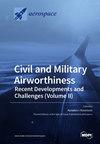Effect of Engine Design Parameters on the Climate Impact of Aircraft: A Case Study Based on Short-Medium Range Mission
IF 2.2
3区 工程技术
Q2 ENGINEERING, AEROSPACE
引用次数: 0
Abstract
The climate impact of aviation is considerably different from that of other transport modes. The turbofan engine’s efficiency can be increased by increasing the Operating Pressure Ratio (OPR), bypass ratio (BPR) and Turbine Inlet Temperature (TIT), thereby reducing CO2 and H2O emissions. However, this may have an adverse effect on the secondary emissions, such as NOx, soot, etc. Taking a holistic view in evaluating the climate impact of engine development trends considering all the climate forcers is imperative for design trends in the future. This research investigates the impact of some key engine design parameters on climate. The emission changes due to design variations in the CFM56-5B are estimated using in-house engine performance and emission prediction tools. Accordingly, the changes in the species’ Average Temperature Response for 100 years (ATR100) are analyzed using a climate assessment tool, AirClim. The results show that the overall climate impact increases by 40% when increasing OPR from 25 to 40. Meanwhile, the Twin Annular Premixed Swirler (TAPS-II) combustor reduces the total ATR100 drastically, in the range of 52–58%, due to lean combustion.发动机设计参数对飞机气候影响的影响:基于中短程飞行任务的案例研究
航空对气候的影响与其他运输方式有很大不同。可以通过提高工作压力比(OPR)、旁通比(BPR)和涡轮入口温度(TIT)来提高涡扇发动机的效率,从而减少二氧化碳和水的排放。然而,这可能会对氮氧化物、烟尘等二次排放产生不利影响。在评估发动机发展趋势对气候的影响时,必须全面考虑所有气候影响因素,这对未来的设计趋势至关重要。本研究调查了一些关键发动机设计参数对气候的影响。使用内部发动机性能和排放预测工具估算了 CFM56-5B 的设计变化导致的排放变化。相应地,使用气候评估工具 AirClim 分析了物种 100 年平均温度响应(ATR100)的变化。结果显示,当 OPR 从 25 增加到 40 时,整体气候影响增加了 40%。同时,双环预混漩涡(TAPS-II)燃烧器由于采用贫燃烧,ATR100 的总影响大幅降低了 52-58%。
本文章由计算机程序翻译,如有差异,请以英文原文为准。
求助全文
约1分钟内获得全文
求助全文
来源期刊

Aerospace
ENGINEERING, AEROSPACE-
CiteScore
3.40
自引率
23.10%
发文量
661
审稿时长
6 weeks
期刊介绍:
Aerospace is a multidisciplinary science inviting submissions on, but not limited to, the following subject areas: aerodynamics computational fluid dynamics fluid-structure interaction flight mechanics plasmas research instrumentation test facilities environment material science structural analysis thermophysics and heat transfer thermal-structure interaction aeroacoustics optics electromagnetism and radar propulsion power generation and conversion fuels and propellants combustion multidisciplinary design optimization software engineering data analysis signal and image processing artificial intelligence aerospace vehicles'' operation, control and maintenance risk and reliability human factors human-automation interaction airline operations and management air traffic management airport design meteorology space exploration multi-physics interaction.
 求助内容:
求助内容: 应助结果提醒方式:
应助结果提醒方式:


